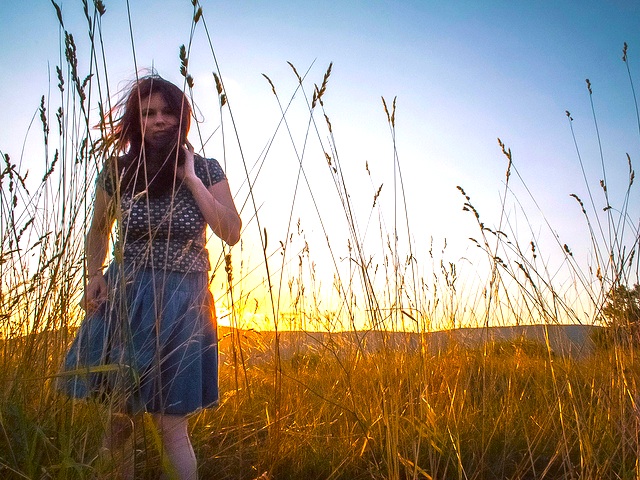
“If you’re not terrified of the next step, you eyes are still closed. A caged bird in a boundless sky.” ~Jed McKenna
It was day two of living at the Zen Center. Sitting on the side of the dirt path, I had my head buried in my knees.
“I can’t do this babe,” I cried to my husband.
Just 12 days prior to this, I was a corporate banker and real estate agent in Phoenix. Now, I was a full-time Zen student deep in the mountains of Carmel Valley, working in the dining room and serving summer resort guests.
“I’ve never even waitressed before. I sat in front of a computer the past decade doing seemingly important work. And now—now, I’m scraping food into a compost bin?” I sniffled.
An hour before then, I’d held back tears the entire time as the dining room crew head was showing me how to set up a tea table and fill tea caddies.
Before coming to Carmel Valley, we’d rented out our comfortable, suburbia five-bedroom, three-bath home. Now, we were living in a 10 x 8 rustic Japanese cabin at the base of a canyon, completely offline from the digital world.
I was sharing a bathroom with 10 other women.
“I’m not a nature girl either. I can’t sleep alongside spiders. Each time I close my eyes, I see a creepy crawler,” I continued to vent, in between an endless stream of tears, gasping for air to get all the words out. “I grew up in suburbia with pest control.”
This life was a radical change. It felt like I’d decided to go cliff jumping—and there was no net.
My conscious decision to leave all the worldly ambitions behind and take this sabbatical year came from my deep belief in taking a pause. Iknew on so many levels that I needed to be there.
But being there, scraping food and living alongside nature critters—not how I had exactly imagined it.
“99 more days” (until I would leave Tassajara) I would write in my journal.
Then, the next day: “98.”
Each day during a work break, I would count backwards until the day when I would emerge into the world again.
As the summer went on, everywhere I looked, it was just me. When I spoke, I could hear myself speak that much clearer.
“Wow, I sure talk about myself a lot,” I’d often think.
When I moved, I could feel my body. When I was sad, I could feel the sadness much more. When I was not self-compassionate, I really felt that too. Something was stirring up internally.
I continued to spend that first month in daily tears, wondering what I was really doing there and whether I really believed in this Zen work practice gig.
Then, there was a palpable shift.
It was my day off and I was hiking on Tony Trail, a steep mountain that overlooked all of Tassajara. It was my favorite path and pastime at the Zen Center. It was an ordinary hike, an ordinary day.
Suddenly, like the freshness of the most peaceful Sunday morning, an immense sense of energetic joy arrived.
This awareness lasted but for a moment, a short, unexpected visit. Then it slipped away.
The sun was now setting and I began my hike back. I was still in awe of that loving, freeing feeling. It left me refreshed, as if I had been basking in the most healing sun of an open, clear sky.
I did nothing to invoke it. It was effortless.
I was consciously aware that this was the first time I even had this capacity for joy without some external cause. My prior happiness was conditioned to come from the outside: a promotion, closing a deal, a nice dinner, a great workout, or achieving some new goal.
Was I so habituated to look outside of myself? Was my attention in my prior life so caught in seeking constant pleasure, happiness, and comfort out there?
Perhaps I didn’t have to struggle and try and look and do, do, do to find it outside. Perhaps I just needed to learn to relax—enjoy the stillness of an ordinary hike—and be with what has been with me all along.
Perhaps when I didn’t try so hard, peace would then show herself.
That day I began to notice the ripples of change.
Here are the four biggest lessons on embracing change that I’ve learned on this journey so far:
1. Start right here.
Each of us is capable of living a peaceful life. We can quiet the mental, fear-based fight that contracts us—the voice that says an older version of ourselves is in fact who we are, that we are not fit for change.
When I first arrived at Tassajara, my comparing mind was in full force. Everything I did I compared to my prior life. The struggle against what was present was constant, as I’d always be shifting the moment, comparing my current experience to an experience in the past.
When I began to start where I was—fresh, like the beginner and not the know-it-all—each day became more inviting and abundant.
Start right here with acceptance of the bare moment. When we stop comparing ourselves to an older version of self, anything is possible.
2. Things are always changing.
Whether we are cognitively aware or not, each moment is always changing. Nothing lasts forever. As human beings we are equipped to move and expand with this natural flow.
Change is an inevitable part of life. The sooner we can accept this as fact, to become acquainted and comfortable with change versus treating it as an interruption in our life, the sooner we can feel more grace.
To grow in this life requires the courage to continuously move with change.
3. We adapt.
I’m constantly in awe at how adaptable we each are.
Science tells us so. The physiological mechanism behind an emotion is this: the emotion only lasts just ninety seconds from the moment it’s triggered until it runs its course. (It’s our harboring of mental energy, the chatter of thoughts, which fuels our emotions beyond that minute and a half).
A habit takes 21 days to form.
Neuroscience tells us our brains have the extraordinary capacity to transform with experience; we can rewire our patterns.
We are each so amazingly adaptable. We learn new skills and are capable of continuously evolving. Give yourself permission to get out of our own way.
4. Meditation helps.
A meditation practice is an opportunity to be the observer of the perpetual stories we tell ourselves. It is an opportunity to be with the discomfort, the chatter, the fear, the excitement, the thousands of thoughts—and not have to do or fix anything. It’s a gift to simply bear witness to all our feelings and thoughts.
For me, it’s been a powerful tool. I could not imagine stepping into this drastic change without a daily meditation practice to ground me.
Particularly during times of change, our minds have a heightened ability to dramatize our responses. It reminds me of what Byron Katies says, “Reality is always kinder than the story we tell about it.”
A meditation practice is a chance for us to clearly see ourselves, the ability to really see what is happening, and that our thoughts are merely that—thoughts.
The End of Summer
It was now fall and the summer resorts guests had gone. The Zen Center was preparing for the coming monastic practice period for the monks. Leaves were changing, and the ambience was more still, almost melancholy.
My husband and I were getting ready to hike out of the canyon and go into the city.
With tears puddled in my eyes—something I had become very good at forming in these months—we began the hike before sunrise. I said goodbye to a life-changing summer, and was now counting the number of days forward until I would return to Tassajara.
Change happens when we stay open.
When we are able to surrender to that net-less cliff jumping and stay with the uncomfortable groundlessness, we begin to take one courageous step, however tiny. Then we take another step.
We learn to adapt, again and again.
And then, suddenly, we’ve adapted. And we have trekked an entire new adventure into ourselves.
Photo by ‘ajnagraphy’
About Cat Li Stevenson
Cat is an explorer of the human journey and a lover of well-being. She is living and practicing at an urban Zen Center in San Francisco, and working for Wisdom 2.0, an organization that strives to bring wisdom and awareness into the digital age. You can add her as a friend on FB or find her writing on Medium.













 Though I run this site, it is not mine. It's ours. It's not about me. It's about us. Your stories and your wisdom are just as meaningful as mine.
Though I run this site, it is not mine. It's ours. It's not about me. It's about us. Your stories and your wisdom are just as meaningful as mine. 